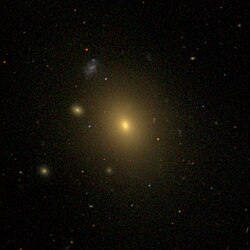NGC 3937
Appearance
(Redirected from NGC 3937 Group)
| NGC 3937 | |
|---|---|
 SDSS image of NGC 3937. | |
| Observation data (J2000 epoch) | |
| Constellation | Leo |
| Right ascension | 11h 52m 42.6s[1] |
| Declination | 20° 37′ 53″[1] |
| Redshift | 0.022242[1] |
| Heliocentric radial velocity | 6668 km/s[1] |
| Distance | 311 Mly (95.3 Mpc)[1] |
| Group or cluster | NGC 3937 Group |
| Apparent magnitude (V) | 13.43[1] |
| Characteristics | |
| Type | E,[2] S0^-[1] |
| Size | ~200,000 ly (60 kpc) (estimated)[1] |
| Apparent size (V) | 1.8 x 1.6[1] |
| Other designations | |
| UGC 06851, PGC 037219, MCG +04-28-081[1] | |
NGC 3937 is an elliptical[3][4] or a lenticular galaxy[5][3][4] located about 310 million light-years away[5] in the constellation Leo. It was discovered by astronomer William Herschel on April 27, 1785[6] and is classified as a radio galaxy.[3][7]
NGC 3937 Group[edit]
NGC 3937 is the brightest[8] member of the NGC 3937 Group, which is part of the Coma Supercluster.[9][10][11][12] The group has a velocity dispersion of 306 km/s. Other members of the group are NGC 3910, NGC 3929, NGC 3940, NGC 3943, NGC 3947, NGC 3954, with NGC 3919 having an uncertain membership.[9]
See also[edit]
References[edit]
- ^ a b c d e f g h i j "NASA/IPAC Extragalactic Database". Results for NGC 3937. Retrieved 2020-05-16.
- ^ "HyperLeda". Search by object designation. Retrieved 2020-05-16.
- ^ a b c "NGC 3937". sim-basic. Retrieved 2020-05-16.
- ^ a b "HyperLeda -object description". leda.univ-lyon1.fr. Retrieved 2020-05-16.
- ^ a b "Your NED Search Results". ned.ipac.caltech.edu. Retrieved 2020-05-16.
- ^ "New General Catalog Objects: NGC 3900 - 3949". cseligman.com. Retrieved 2020-05-16.
- ^ "Your NED Search Results". ned.ipac.caltech.edu. Retrieved 2020-05-16.
- ^ Ma, Chung-Pei; Greene, Jenny E.; McConnell, Nicholas; Janish, Ryan; Blakeslee, John P.; Thomas, Jens; Murphy, Jeremy D. (2014-10-28). "The MASSIVE Survey - I. A Volume-Limited Integral-Field Spectroscopic Study of the Most Massive Early-Type Galaxies within 108 Mpc". The Astrophysical Journal. 795 (2): 158. arXiv:1407.1054. Bibcode:2014ApJ...795..158M. doi:10.1088/0004-637X/795/2/158. S2CID 119204463.
- ^ a b Gregory, S. A.; Thompson, L. A. (June 1978). "The Coma/A1367 supercluster and its environs". Astrophysical Journal. 222: 784–799. Bibcode:1978ApJ...222..784G. doi:10.1086/156198.
- ^ Tifft, W. G.; Gregory, S. A. (July 1979). "Band theory applied to the Coma/A 1367 supercluster". Astrophysical Journal. 231: 23–27. Bibcode:1979ApJ...231...23T. doi:10.1086/157158.
- ^ Chincarini, G. L.; Giovanelli, R.; Haynes, M. P. (May 1983). "The geometry of two superclusters coma-A1367 and Perseus-Pisces". Astronomy and Astrophysics. 121: 5–9. Bibcode:1983A&A...121....5C.
- ^ Gavazzi, G.; Carrasco, L.; Galli, R. (April 1999). "The 3-D structure of the Coma-A 1367 supercluster: Optical spectroscopy of 102 galaxies". Astronomy and Astrophysics Supplement Series. 136 (2): 227–235. Bibcode:1999A&AS..136..227G. doi:10.1051/aas:1999209.
External links[edit]
 Media related to NGC 3937 at Wikimedia Commons
Media related to NGC 3937 at Wikimedia Commons- NGC 3937 on WikiSky: DSS2, SDSS, GALEX, IRAS, Hydrogen α, X-Ray, Astrophoto, Sky Map, Articles and images
